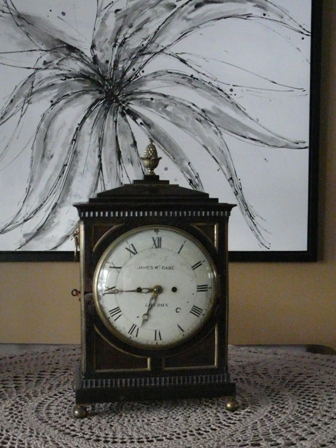Did you know we repair antique clocks?We also repair antique clocks. Give us a call to discuss your repair needs. Here's some helpful hints about antique clocks: Clock hands and dial features
|

Library Clock by James McCabe, London. c1810 The ebonized case has glazed doors to the front and rear and a beveled glazing to the raised top. There is fish scale brass fretwork to each side with green silk backing. The case has clean lines with decorative molding under the freeze and an ogee molding above the plinth.
Painting by Toronto artist Daniel Schneider |
Case and movement features
- gold electroplating was introduced in 1836 and became popular within a few years. It provided a safe alternative to the hazardous use of mercury in gilding metals, which was banned c. 1799.
- calendar movements were introduced to English longcase clocks c.1660.
- machine made wood screws were introduced as early as 1806 in France.
- reverse-painted glass tablets date from the early 1800’s.
- wooden movements were generally used in early American shelf clocks until around 1820, since up until then hand cast and finished brass movements were very expensive. Chauncy Jerome began manufacturing cheap 30-hour brass movements in the 1830’s; by the early 1840’s brass movements virtually replaced wooden ones.
- coiled wire gongs were used in English bracket (shelf) clocks beginning around 1840
- chime bars, also called chime rods, were introduced to clocks c. 1890. They are metal rods specially tuned to produce a sequence of chime notes when struck by the movement's chime hammers.
- celluloid was patented in 1869. "Adamantine" celluloid veneer was patented in 1880. In 1882 Seth thomas introduced clock models in Adamantine veneer finishes which mimiced marble, slate, wood grains and other materials. More information and examples of Adamantine clocks can be found at Bill Stoddard's ClockHistory.com web site
- Bakelite (an early nonflammable, moldable plastic) was invented by a Belgian born scientist Dr. Leo Baekeland, who founded the Bakelite Corporation around 1910. It reached its height of popularity in the 1930's and 40's and was used in a wide variety of consumer products. Examples of clocks with Bakelite cases can be seen at Mike Schultz's Reverse Time web site.
- marking the country of origin was required after 1896 on clocks imported to the United States; e.g. "Made in England" or England", "Made in France", "France", etc.
- The "Anniversary" trademark on 400-Day clocks was introduced 1901.
- Plywood was first used in 1905.

